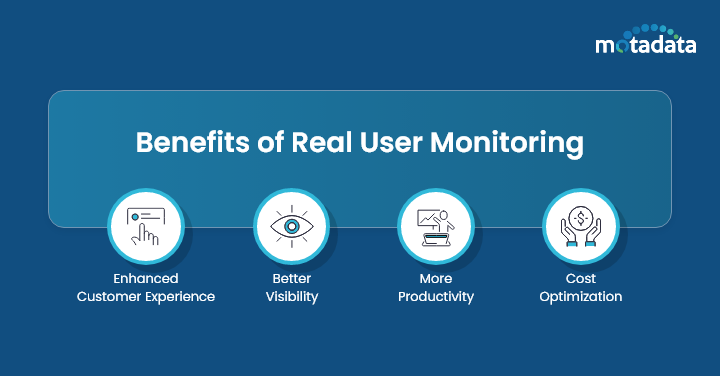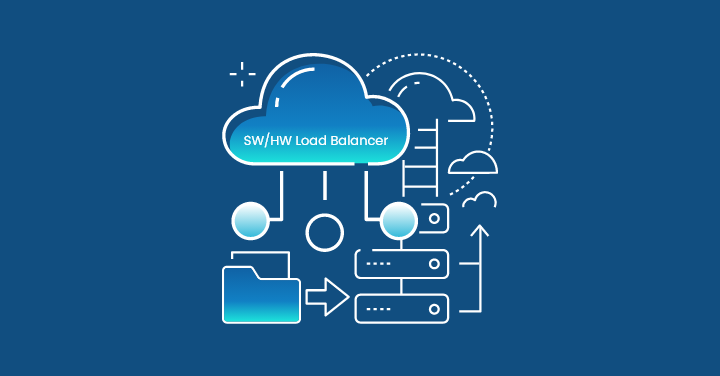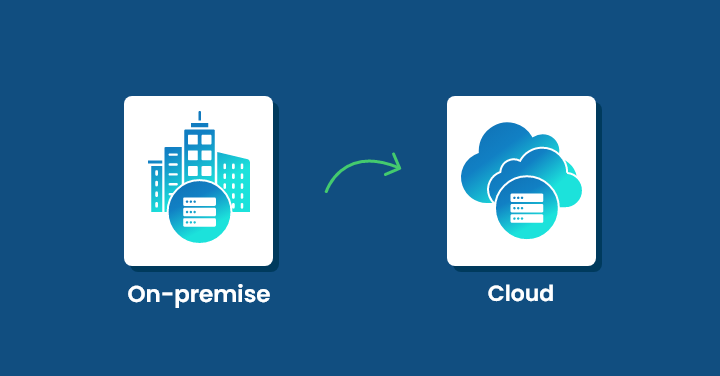Today, more than 90% of businesses use digital platforms to sell their services and products online. But what if despite getting high traffic from different sources your sales count is below your expectations? What if customers are visiting your product page but exit before making any purchase?
Well! To get more insights into the performance issues and user experience, many businesses have started investing in a real user monitoring tool that captures all details related to user behavior and experience. Let us delve deeper into the concept of real user monitoring (RUM) – how it works, its importance, examples, benefits, limitations, and challenges. Further, we will highlight some of the common features and best practices of Real User Monitoring in this post.
What is Real User Monitoring?
Real User Monitoring (RUM) is a popular technique used by most businesses to get insights into how users interact with a website and their overall experience with an application. The RUM tool helps collect, capture, analyze, and report all user activities and performance issues in real-time. Unlike other monitoring techniques, such as application performance monitoring or synthetic monitoring tools, it focuses more on understanding user behavior and ways to improve user satisfaction.
How Does Real User Monitoring work?
All you need to do is embed a tracking code within the web pages of a website or application to capture all user data. As the code gets inserted, it will start collecting all the information related to user actions, performance issues, user behavior, and page load time. This embedded code will keep track of the total number of clicks, page views, etc, in real-time. Further, with the help of this solution, businesses will be able to monitor the server response time, page load time, and other key performance metrics.
Once all the data is collected by the embedded code, it is passed to a centralized monitoring system for further analysis and report creation. With the help of these insights, team members can optimize their performance, make informed decisions, and improve user satisfaction.
Importance of Real User Monitoring
All businesses that wish to improve their user experience and maximize their online presence must invest in real user monitoring tools. The robust tool provides user-centric insights into the overall application performance, detects bottlenecks in real time, and helps discover revenue-boosting opportunities.
By using real user feedback and behavior as a basis for decision-making, businesses can optimize their digital services for maximum customer satisfaction and engagement. This data also plays a critical role in Customer Data Analytics, helping organizations better understand user trends and preferences.
Basic Steps in Real User Monitoring
RUM is an essential process since it offers a comprehensive view of the user’s experience and interactions with the application. With these insights, businesses can work on the areas that require optimization and improve customer satisfaction levels.
Here are the Basic Steps in Real User Monitoring:
Data capture – collects all the information related to user clicks, page loading time, response time, and transactions
Sessionization – compiles all the captured data into a record
Problem Detection – Analyzes the unusual behavior for different pages, i.e., slow response time, navigation error, etc.
Reporting – After analyzing issues, it generates a report highlighting how a user interacts with the application and what are the areas that professionals need to fix.
Alerting – Triggers an alert mechanism on identifying a major issue.
Examples of Real User Monitoring
- Almost any program that has a UI can gain from regular real-time user monitoring. For example,
- Tracking retailer’s web inventory to spot any sudden increases in page load times
- Monitoring user journeys across the conversion funnel and applying that information to determine revenue
- Giving developers information about service delays to assist them find code that isn’t working well
- Identifying variations in an application’s performance when viewed on several mobile device types
Benefits of Real User Monitoring
Here are some of the main benefits of using Real User Monitoring Software –
1. Enhanced customer experience
With RUM, users can track what pages a visitor is often clicking, pages that are taking longer time to load, and customers exit the page in seconds. Basically, it collects all the transaction data in real-time and gains a clear understanding of a user’s actual behavior. These insights can be further used to understand who is impacted by outages or bad user experiences.
2. Better visibility
RUM looks into a website from the viewpoint of the user to find and report unforeseen problems, like how quickly pages load in various locations and browser versions.
With in-depth visibility, users can find and address issues before they impact the customer experience. A skilled website designer in Geelong can optimize your website for better performance and user experience.
3. More Productivity
It might take a lot of time and resources to manually identify usability and performance problems with websites. However, RUM helps automatically identify performance issues with websites and enables developers to quickly fix them in real-time without requiring extra effort.
4. Cost optimization
RUM assists businesses in resource optimization by identifying performance bottlenecks and errors that might impact user experience. By incorporating this tool, businesses will be able to more effectively allocate resources, which lowers infrastructure expenses, whether it is through improving code, recognizing third-party services causing delays, or simplifying server usage.
Limitation of RUM
There are also certain drawbacks of using Real User Monitoring Solution, including:
1. Lack of Benchmarking – When comparing the performance of your website to competitors’ or industry norms, RUM’s lack of external benchmarking data can be a challenge.
2. Difficult to Monitor Pre-deployment Performance – Users cannot measure the true status or potential problems in a website that might affect the user in the coming period without making it live. Basically, if performance cannot be simulated and evaluated in a controlled setting, there is a risk that unanticipated issues will surface after launch.
3. Excessive Data – The tool might generate a large amount of data for monitoring and logging. However, large-scale data management and analysis can make it difficult to get critical insights and may even make you miss key performance indicators.
Real User Monitoring Tools
Businesses can improve the overall health and performance status of each application with the powerful features supported by the RUM tool, such as:
Correlating user experience and website performance – With the help of this solution, businesses can get a better understanding of the relationship between website performance and user experience.
For example, the percentage of bounce rate is rate is increasing due to page load speed.
Historical data analysis – Critical metrics including bounce rate, total connection requests, and more can be tracked and reported by these tools as well as provide a quick summary of how these metrics have changed over time.
API Support – Uses RESTful APIs to integrate RUM with existing portals or reporting systems for creating custom scripts and workflows.
What RUM metrics can you monitor with a monitoring solution?
Here are some of the vital metrics that one can track using these robust monitoring solutions, such as:
Page Load Time – This metric gives an update on the time a webpage is taking to appear on the client browser.
Active Users – This metric displays the count of actual users that visited your website and have been available for a given period.
User Satisfaction Time – A numerical value that expresses how satisfied a user is with the functionality of a web application.
Bounce Rate – The percentage of internet users that leave a website right away after visiting one of its pages.
Connection requests – This metric shows the total count of HTTP requests made to a certain web server in order to retrieve site content.
JavaScript errors – Details regarding any faults with JavaScript that are showing up in the browser of the end user.
Key Components of Real User Monitoring
There are several key components in a RUM tool:
Data Collection Agents – These are the embedded JavaScript codes that help collect and capture all the user and performance data in real time.
Transmission Protocol – A method that helps transfer all the gathered data to a centralized monitoring system.
Data Storage – Infrastructure to store and run a root-cause analysis of data that has been gathered from different sources to gain quick insights.
Reporting – Generating insightful reports with graphs and charts for making informed decisions.
Challenges of Real User Monitoring
No doubt RUM offers detailed and valuable insights into user experiences, but there are certain challenges that one needs to be aware of, such as:
1. Data volume dependency:
RUM generates big data sets but if your site receives little or no traffic, chances are it won’t produce accurate results. Therefore, in order to fully utilize RUM, it is best to invest in the tool when your audience grows.
2. Expensive tool:
Because large firms have extensive client bases, implementing and maintaining tools can be expensive. Hence, make sure your company can adequately fund RUM by evaluating its financial situation before you start.
Best Practices of Real User Monitoring
Here are some of the best practices that can help your business maximize the advantages of real user monitoring.
1. Set clear business objectives:
Set measurable goals like a 15% reduction in abandoned carts or a 20% Decrease in the bounce rate. With clear business objectives, team members can concentrate on development efforts and identify appropriate areas of user behavior that require more attention.
2. Measure RUM for web and mobile applications:
Incorporate RUM for both mobile and web-based applications for better results. This strategy will help provide insights into performance issues with mobile applications as well.
3. Integrate RUM in test environments:
During the development phase, if you include RUM in your test environments, you will get insights into errors, performance bottlenecks, and usability issues in real time. With this proactive strategy, you can reduce load times, improve user experiences, and guarantee a seamless transfer to production—all of which lead to a final product that is more polished and responsive.
Common Real User Monitoring Features
Here are a few common features of real-user monitoring software:
Real-time Monitoring – Monitors the different metrics and user interactions in real-time
Alert Options – Sends automated alerts to system administrators notifying them about performance bottlenecks and errors using different channels
Customizable Dashboards – Visualizes different performance metrics and reports on user behavior
Performance Benchmarking – Evaluates performance indicators in relation to established industry norms or benchmarks.
How is Real User Monitoring different from application performance Monitoring (APM) and synthetic monitoring?
Real User Monitoring (RUM) and APM or Synthetic monitoring might sound similar but differ in many ways. RUM works on the real-world approach, i.e., keeps an eye on real users to give insights into how a website or service functions. Synthetic monitoring, on the other hand, uses simulated data to determine how a site needs to function in real-world scenarios.
Secondly, RUM focuses more on user behavior and interactions, whereas, synthetic monitoring focuses on the performance of infrastructure components like servers and databases. Additionally, RUM supports user segmentation, unlike synthetic monitoring.
Choosing the Right RUM Tool for Your Business
Here are a few things to consider when selecting the right RUM tool for your organization:
1. Custom events creation
Make sure to invest in a tool that supports creating custom events as it will help identify workflow issues in real-time. Let’s say you created an event on your landing page targeting users who want to apply for the 30-day fitness challenge. These stats will help you determine how many users got engaged with the new feature and what percentage dropped without enrolling. With these insights, you may now focus on making changes that will maximize the user experience.
2. Implementation options
When choosing an RUM tool, it is important to investigate several implementation possibilities. Think about whether the tool supports techniques that are compatible with your application architecture and technical setup, such as SDK integration or JavaScript injection. Selecting a tool with an appropriate deployment option guarantees more seamless adoption and precise user experience insights.
3. Data handling
View how the tool uses observability data and handles storage data and other data types with the chosen monitoring solution. To safeguard user privacy and guarantee regulatory compliance, proper data handling is essential. Hence, select a RUM tool with strong data handling procedures as it will promote user trust and guarantee the protection of sensitive data during the monitoring process.
Conclusion
Real User Monitoring is one of the popular tools when it comes to assessing and enhancing user experience on websites and applications. The robust tool provides important insights into user behavior, performance metrics, and the general condition of digital assets by gathering data in real time from actual users. Issues like high bounce rates, unsuccessful transactions, and more can be found and fixed with RUM.
There are several benefits to using the RUM tool but it also comes with certain limitations and challenges. However, by following the above-listed best practices any business can overcome the challenges and improve user experience. By properly analyzing and measuring all collected insights, businesses can make sure their online presence fulfills user expectations and promotes commercial success.
FAQs
Real-user monitoring provides real-time updates on the user interaction and behavior with the website or application. It provides valuable insights into the response time, loading time, and other performance metrics that may affect real users, unlike other monitoring techniques.
Through RUM data analysis, companies may pinpoint and fix problems to improve user experience and maximize the functionality of their websites or applications.
JavaScript code snippets are used to implement Real User Monitoring on websites or applications. The data that these snippets gather includes click events and page load times related to user behavior. After implementing the code, the server receives all the data for reporting and analysis. RUM is often implemented using tools like New Relic and Google Analytics.
With the ability to collect data from a wide variety of user contexts and devices, RUM provides insights into how various browsers, operating systems, devices, and networks behave.
Achieving compliance with privacy requirements necessitates being open and honest about data collection and usage, getting explicit agreement from users, anonymizing personal data, and following pertinent laws like the CCPA or GDPR.










